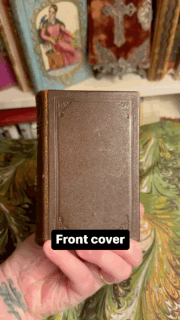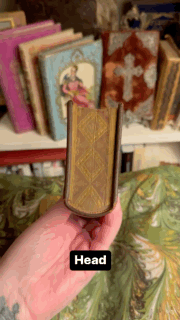Secrets on the Edge: Fore-Edge Paintings
New York Public Library
This is an edited transcription of an episode of my YouTube series, Bite Sized Book History. Check out the video version here!
Hidden fore-edge paintings are a magical aspect of book arts, and the subject of many viral videos. When did they first appear, and how do you make them, anyway?
But before we get too deep into fore-edge paintings, let’s go through a little bit of book anatomy, with help from this 19th-century French prayer book. This probably looks a lot like books on your shelf, and it has the same anatomy as any other book. This is the codex format, which means basically it’s a bunch of pages sandwiched between two covers. So, starting at the front, we have the front cover, the back cover, and the spine. But the fun begins on the edges.
The “head” edge is the one at the top, the “fore” edge is on the side facing the spine, and the “tail” edge is on the bottom. You can see that the edges on this book are very exciting and very shiny! This is an example of a fore-edge painting, so called because it’s on the fore edge. Painted edges first appear on manuscripts from the 10th century. Most early examples feature ornamental or heraldic elements.
University of Edinburgh MS 2, c. 1300 Biblia Sacra
You’ll notice that all the examples I’ve shown so far are not hidden at all. They’re right smack-dab on the edge of the book, visible to anyone who might want to see them. That’s because, until around the mid-16th century, books were often shelved fore-edge out. Readers and owners would just write the title or the shelfmark directly onto the exposed edge. Or, if the reader or owner was spectacularly rich, they could commission an artist to make their edges look a bit more fabulous.
Part of the Pillone Library, now at the Beinecke Library, Yale
This collection of books, now part of Yale’s Beinecke Library, once belonged to the Pillone family of Italy. In 1580, Odorico, head of the wealthy family, commissioned Titian’s cousin to decorate a portion of the family library. The titles include works by authors like Cicero, Thomas Aquinas, and Erasmus, among others, many of which are decorated with portraits of their authors.
The ever-popular hidden fore-edge paintings pop up occasionally before the 18th century, but it didn’t really take off as an art form until the Edwards of Halifax firm came on the scene, in the late 18th century. The Edwards were an eccentric family of booksellers from Yorkshire, and I do mean eccentric. James Edwards, son of the firm’s founder, was actually buried in a coffin made of wood from empty bookshelves! Like many booksellers of their day, they maintained a bindery, and their creativity led to the development of several new styles of bookbindings, including the hidden landscape fore-edge painting.
Edwards bindings auctioned by Christies in 2020
The Edwards pioneered the ambitious practice of adding detailed urban and rural scenery to the edges of books, and their fabulous works even caught the eye of King George III, whose notable patronage increased the renown of the Edwards shops. The artists of these hidden fore-edge paintings are most often anonymous, even in the case of a well-known firm like Edwards of Halifax, however, like many anonymouses throughout history, there is evidence that at least some of the fore-edge painters were women.
Image from Drawing Covert
So, how do you make a hidden fore-edge painting in the first place? It’s surprisingly simple. First, fan out the edges of your book in a press like this one. Then, paint your scene, and let it dry. Finally, let the book return to its original shape, and apply gold leaf to the edges. And voila! You have hidden your fore-edge painting.
Although some sensational stories and videos claim that producing hidden fore-edge paintings is a dead or dying art, they are still being produced. Artists such as Bri Marie, Martin Frost, and Margaret Costa follow in the tradition of Edwards of Halifax.
And modern artists, such as Ed Ruscha, have also put their spin on the art form. This work from 2008 entitled “Oh No” continues to be a big mood. If you’re a book artist who has incorporated hidden fore-edge paintings into your work, drop a comment below. I would love to see what you’ve done with the art!
[Transcription by Alex Kyrios]
Sources and further reading:
MARKS, P. J. M. “THE EDWARDS OF HALIFAX BINDERY.” The British Library Journal, vol. 24, no. 2, 1998, pp. 184–218. JSTOR, www.jstor.org/stable/42554500.
https://www.abaa.org/member-articles/a-collectors-primer-to-the-wonders-of-fore-edge-painting
http://www.clarebrooksbank.co.uk/index.php/category/1-fore-edges
https://collation.folger.edu/2018/02/naval-binder/
https://en.wikipedia.org/wiki/Fore-edge_painting
Weber, Carl Jefferson. Fore-edge painting: a historical survey of a curious art in book decoration, Harvey House, 1966.
https://news.yale.edu/2019/03/14/painted-renaissance-volumes-view-yales-beinecke-library
http://blog.nyhistory.org/fore-edge-paintings/







